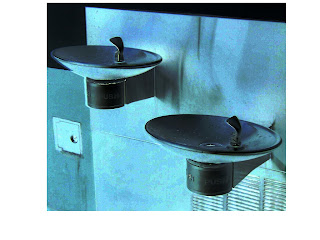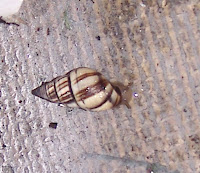Baskets are an inexpensive way to add texture to a room, as well as providing storage. Often, they can be found for a buck or two at a thrift store, rather than buying them new.
I use baskets on my wall unit of shelves.

These two baskets are larger than they look. The wicker basket, right, is a lunch box with a lid with clever handles that lock shut -- perfect for a quiet lunch alone in a park. A subtle diamond pattern woven into the front of it is too subtle to capture on camera. It holds computer program CDs and instruction booklets for computer electronics, such as this camera.
The red one hides an entire Leggoes box that I use for a classroom demonstration activity. There is a close-up below.


The next basket on the wall shelves holds music CDs. Lighter and darker reeds are interwoven to create an interesting pattern.
These three baskets, below, are grouped against a small wall for the time being.
The very large picnic hamper holds my sewing supplies. I've placed a tray on top of it -- you can see the blond wood rim -- to create a flat surface, so the other baskets don't sit askew. The square basket and pale reed basket with a graceful kidney-shaped top edge are being re-purposed as I reorganize my living space.

This use of a basket as a lampshade, below right, never worked out; it always sits lopsidedly. It currently resides in a corner behind my recliner that is a
holding pen as I decide what to put where in my clean-up. I'd forgotten about the large round basket until I noticed it in the background. As you can see, it is a trash basket. It is not usually overfilled and serves more discreetly as my circular file. It is roughly brushed with white paint in a shabby-cottage effect.

I also forgot about this nifty harlequin basket, below, until I wrote about the other trash basket. I keep dashing off to take more photos as I write. This jaunty harlequin serves as a petite trash container in the
jungle room half-bath. It cost a buck at the dollar store and is one of the few that I purchased new.

The little rope basket, below, holds extra hand towels in the jungle room. The two sides with their scallops resemble seashells. The spokes and handle are wicker.


The next two photos show my file-tray basket. In a one-bedroom apartment, I hide my printer behind a lamp in a dark corner of the room. Even the "end table" on which it sits serves a storage purpose; it is my cedar chest for woolens that we so rarely wear here in Florida.


Baskets are great for stashing paper -- bills, receipts, and mail offers about which I'm undecided. Two are shown below and in close-ups. I like the way rattan has been twisted to form a rope that was woven to create the round basket.

Notice how a rough brown twine has been woven into the center section of the long, thin basket, below.


This rustic basket is a refugee from Christmases past. It is woven of a flat bark or reed about an inch wide to form a diamond weave. These have been faintly brushed with red and green that does not show unless you are very close. It is a brittle wood, so I can understand why the maker didn't get the bottom quite flat. It must have been hard to work with this material. It holds everything I need next to my recliner -- eyeglasses, nail kit and hand cream, calculator, bookmarks, you name it.

Spray-painted gold years ago, this basket belongs in storage until the winter holidays. I threw a modular kusudama in for the picture, but the pink and yellow paper is too light to photograph well. Notice how the graceful rounded bottom is centered with a flat coaster-like circle that is woven right into the work so that it will sit right. How clever and practical!

This little basket is the right size to hide a small plastic flower pot. It has a large handle (extends out of the photo), and once hung from a wire plant hook on my patio, until the plant died. Plain rough brown twine forms the X pattern on the body and gold twine accents the top and bottom rims.
This wide variety of baskets adds (I hope) texture yet unity to my main living area. Wait, we're not quite done. There are still the scullery maids in the kitchen.
Once upon a time this lime-green basket accented a tiny bathroom trimmed in that color. Now it holds vitamin pills in the kitchen. Perhaps it's time to repaint it.

Last, these hanging copper wire baskets cost a few dollars at Wal-Mart. Every kitchen should have some, don't you think?

I almost forgot this pair, below. Set on an angle to each other, they contain bathroom clutter in a minuscule space with no storage. Less than four inches wide and 13 inches long, they are a tough rope fiber on wire frames.

In conclusion, you can see that I love baskets. They help keep my clutter in control. I like the way they look, and the price is right.













































